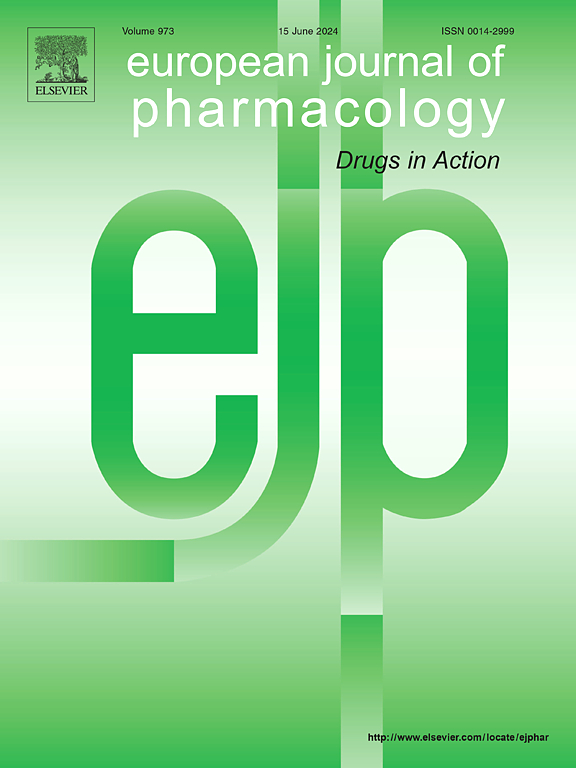Novel applications of metformin in the treatment of septic myocardial injury based on metabolomics and network pharmacology
IF 4.7
3区 医学
Q1 PHARMACOLOGY & PHARMACY
引用次数: 0
Abstract
Background
While metformin has shown promise in treating septic myocardial injury (SMI), its underlying mechanisms and impact on metabolic disturbances remain poorly understood.
Methods
This study employed an integrated approach of metabolomics and network pharmacology to identify key targets and pathways through which metformin may act against SMI. Findings were validated using a lipopolysaccharide (LPS)-induced mouse model.
Results
Metformin was found to counter myocardial metabolic disruptions, indicated by the reversal of 49 metabolites primarily involved in purine metabolism, pantothenate and CoA biosynthesis, and histidine metabolism. In vivo, metformin significantly improved survival rates and cardiac function, reduced cardiomyocyte apoptosis, and inhibited inflammation and oxidative stress in LPS-induced mice. Integrated analyses identified 27 potential targets for metformin in SMI treatment. KEGG pathway analysis revealed significant enrichment in TNF, HIF-1, IL-17, and PI3K/AKT signaling pathways, while protein-protein interaction analysis pinpointed ten core targets, including IL6, IL1B, CCL2, CASP3, MMP9, HIF1A, IGF1, NOS3, MMP2, and LEP. Molecular docking and dynamics simulations demonstrated metformin's high affinity for these core targets. Further, RT-qPCR and Western blot analyses confirmed that metformin modulates core target expression to mitigate SMI. Notably, our data underscore the importance of PI3K/AKT and MMP2/MMP9 signaling pathways in SMI therapy.
Conclusion
This study elucidates the metabolic and molecular mechanisms of metformin in SMI treatment, supporting its potential repurposing for SMI.
基于代谢组学和网络药理学的二甲双胍在治疗化脓性心肌损伤中的新应用。
背景:尽管二甲双胍在治疗脓毒性心肌损伤(SMI)方面已显示出前景,但人们对其潜在机制及其对代谢紊乱的影响仍知之甚少:本研究采用了代谢组学和网络药理学的综合方法,以确定二甲双胍可能对脓毒性心肌损伤起作用的关键靶点和途径。研究结果通过脂多糖(LPS)诱导的小鼠模型进行了验证:结果:研究发现,二甲双胍能对抗心肌代谢紊乱,这表现在它能逆转主要参与嘌呤代谢、泛酸和CoA生物合成以及组氨酸代谢的49种代谢物。在体内,二甲双胍能显著提高 LPS 诱导的小鼠的存活率和心脏功能,减少心肌细胞凋亡,抑制炎症和氧化应激。综合分析确定了二甲双胍治疗 SMI 的 27 个潜在靶点。KEGG通路分析显示,二甲双胍在TNF、HIF-1、IL-17和PI3K/AKT信号通路中具有显著的富集作用,而蛋白-蛋白相互作用分析则确定了10个核心靶点,包括IL6、IL1B、CCL2、CASP3、MMP9、HIF1A、IGF1、NOS3、MMP2和LEP。分子对接和动力学模拟证明了二甲双胍对这些核心靶点的高亲和力。此外,RT-qPCR 和 Western 印迹分析证实,二甲双胍能调节核心靶点的表达,从而缓解 SMI。值得注意的是,我们的数据强调了PI3K/AKT和MMP2/MMP9信号通路在SMI治疗中的重要性:本研究阐明了二甲双胍治疗 SMI 的代谢和分子机制,支持将二甲双胍重新用于 SMI 的可能性。
本文章由计算机程序翻译,如有差异,请以英文原文为准。
求助全文
约1分钟内获得全文
求助全文
来源期刊
CiteScore
9.00
自引率
0.00%
发文量
572
审稿时长
34 days
期刊介绍:
The European Journal of Pharmacology publishes research papers covering all aspects of experimental pharmacology with focus on the mechanism of action of structurally identified compounds affecting biological systems.
The scope includes:
Behavioural pharmacology
Neuropharmacology and analgesia
Cardiovascular pharmacology
Pulmonary, gastrointestinal and urogenital pharmacology
Endocrine pharmacology
Immunopharmacology and inflammation
Molecular and cellular pharmacology
Regenerative pharmacology
Biologicals and biotherapeutics
Translational pharmacology
Nutriceutical pharmacology.

 求助内容:
求助内容: 应助结果提醒方式:
应助结果提醒方式:


